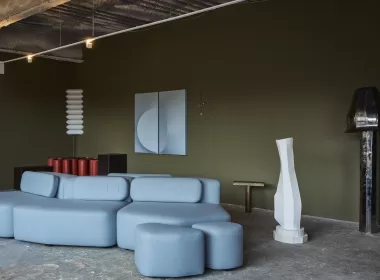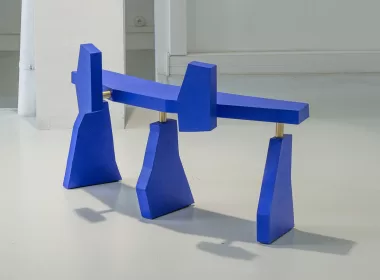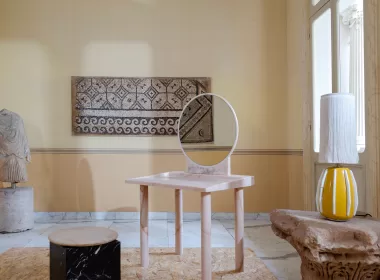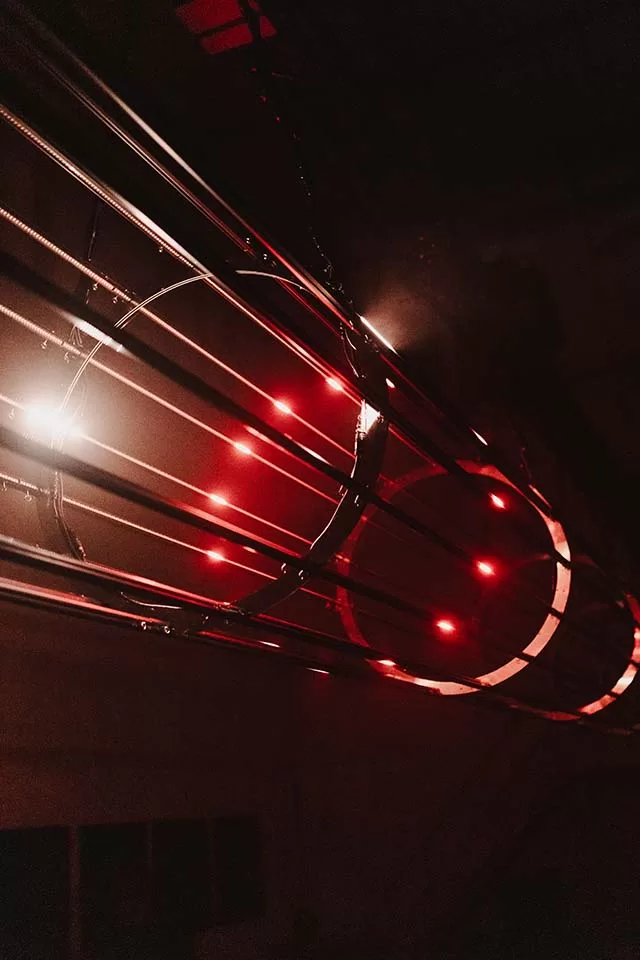An audiovisual live performance concept and installation by Lumus Instruments, a multidisciplinary studio working with light, sound, and structure, Contrarium was first conceived in 2021, with the first editions presented in Lofi, a club in Amsterdam. Two more editions of Contrarium took place at Paradigm Festival in Groningen, with the latest edition at Monopol Berlin, spanning two weekends with eight live electronic musicians. The installation features auditory and visual artists, creating an audiovisual canvas that seeks symmetry and plays with dividing space through light forms that interact live with the music.
Frequent collaborators of Contrarium include musicians such as Max Frimout, Polygonia, and JakoJako. During each live performance, Timo Lejeune, co-founder and co-owner of Lumus Instruments, utilizes TouchDesigner and an audio interface, receiving audio data from the musician. With each audio signal, Lejeune can generate a variety of lighting effects in the installation to complement and enhance the audiovisual experience of Contrarium. This creates a highly collaborative platform where Lejeune and the musicians become fully immersed in improvisation with an equally captivated audience.
At the heart of Contrarium is an enthusiasm for experimentation, manifested through the installation’s continuously evolving physical forms, music, and venues. Bringing forth a new audiovisual conversation with each iteration of Contrarium, Lejeune gives insight into the development of the installation, his involvement, and its future in the realm of live music and a technologically evolving world.
What was your role in the creation of Contrarium?
Timo Lejeune – Contrarium already existed for quite a long time. The whole idea of what we’re doing there for this edition was already known: we wanted to create audiovisual experiments with live performances. For this edition, my role was booking the artists, creating a program with various musicians, discussing what type of performance we were going to do with the musicians, and things that we wanted to try or experiment with. I do the programming, so programming the computer and seeing how everything is working with audio analysis, and performing live– essentially, doing the ‘light side’ of the live performance.
Could you explain more about what you do with the lighting during shows from a live performance perspective?
Timo Lejeune – What I have is TouchDesigner running and I have an audio interface. Through that audio interface, I receive audio through separate channels from a musician. So for example, I have 4 or 6 separate audio signals. I have separate audio channels and I have a MIDI input. In my TouchDesigner interface, I can see all of the incoming data. I select the audio signal that is coming in and the specific effect that I want that sound to work with. I have a range of images or generative engines that use that sound to create an image. Then I post-process the sound a little bit to get the right type of dynamics in the signal, and then I play with the effect itself, like the movement and the color. Every effect is different. I have somewhere between 12 and 20 parameters per effect that I can tweak. This is how I proceed: ‘This is the vibe right now, this is the sound that I want to do something with’. I choose the effect, I work on it, and let it flow.
It’s also not a type of performance where these effects switch very quickly. It’s not timed. It’s slow-moving, evolving, and growing in complexity. That is essentially what I’m doing and sometimes, there is a bit of orchestration. We have some conversations and do some walkthroughs, so I already have an idea of the type of effects and colors that I want to use, but in the moment, everything is controlled live from the whole movement and how everything responds which also makes it difficult.
Some of these can also be automated a bit. I always make a distinction between automating the purely technical things– you want to keep the things that are more playful and creative, that have more of an emotional layer, free. In terms of sound processing, for example, I want to have that as automated as possible because I want to have the best signal and there are not a lot of creative things in how the sound signal is being processed. So this is how I make a distinction for myself. What am I trying to automate the most and where do I want to keep my freedom during the set to feel the atmosphere of the room and control everything accordingly?
How was the idea for Contrarium conceived?
Timo Lejeune – There’s a very big gap between what happens on the audio side and what happens on the visual side. You don’t often see the marriage between those two things happening. Our initial idea was to create a system where this becomes easier and to implement it on a bigger scale. That’s why we started to experiment with the idea of taking signals and putting them into a system where you can manage them to create individual results in real time.
The first audiovisual show we did to experiment with this was in 2018. Then, the first show we called Contrarium was in 2021 and that was more of a package situated with the music artist: we’re facing each other and the audience is also on opposite sides of each other in the room. It’s a setup where the artists are in the center of the whole experience and the crowd is all around.
Our main idea is to create these events to experiment and push the envelope together with musicians to create a statement for the live music industry.
Timo Lejeune – All of these Contrarium shows work with live musicians, so it’s all live sequencers and synthesizers–all live equipment and gear. That’s the only way we can create the experience. We need this kind of data. You don’t have a lot of these sets day-to-day at festivals and clubs. Also, we invest a lot of time in the conversation between the live artist and the musician with Contrarium to talk to each other and ask, ‘What are we going to do together?’. This kind of collaboration became the cornerstone of what Contrarium is. It is a collaborative, inspirational, and experimental project. Our main idea is to create these events to experiment and push the envelope together with musicians to create a statement for the live music industry.
It is not just that we want to do these audiovisual performances, but there is this idea of how we think of this very niche position in live performances. There are a lot of audiovisual performances, but there is not one ecosystem where multiple musicians can use and collaborate. This is something that we are proud of and we think is fun. This whole thing became a platform for more people to experiment and try things out. This is something we want to evolve further into the future. There’s not just this musician and visual artist doing something together. It’s a group of people watching each other’s work too, and cheering on the sideline. That’s a nice feeling, that there is this community and a respectful way of working together and sharing a platform.
The most recent installations feature a cylindrical lighting structure. However, past installations were made up of different shapes and projections. What is the significance behind the shapes and changes that come with each iteration?
Timo Lejeune – I have to name my colleagues Julius Oosting and Timothy Hendriks, with whom I’ve mostly run the company for the last few years. They also played a very big role in the physical size of the installation and how it’s shaped throughout the space. It changes primarily because we want to try something else and our system is made to make changes, but it’s all made of the same element. Whatever setup you see, it’s all the same element we use– we just arrange it differently. We want to experiment with how a different setup creates a different effect.
The cylindrical structure was one way to make the experience more of the same for everybody in the room because everybody can see it and you can play more with the negative spaces in between those lines. It feels like an actual shape within this cage instead of just individual lines. Next time, we are going to try a new shape or an improved version of that installation. This way, we just want to keep on experimenting to keep it fun for ourselves.
What do you think is the future of Contrarium? What’s next?
Timo Lejeune – Because having the spaces to do these things is always expensive, or it’s rare to have these spaces, especially for a long time, we need to do a lot of shows. This is fun for us, and a lot of people have an interest in it, but it means that you don’t have a lot of time to practice with the musicians. We see that as a big value: spending time with the musician in these installations, practicing, doing run-throughs, and trying new stuff out without an audience. So for the next durations of Contrarium, the goal is to build more time for that– not to make the sets completely pre-programmed, but to invest more time in thinking about the story that we want to tell. I think that will be a very, very big improvement in how these shows are experienced.
Technology should be used in a way that empowers the creative spirit of people and not merely to keep on automating everything.
Lumus Instruments is described as future-forward. How do you believe Contrarium fits into that future-forward mindset?
Timo Lejeune – Technology should be used in a way that empowers the creative spirit of people and not merely to keep on automating everything. If we use technology to automate something, we won’t have to do it anymore. I think being on stage and performing live and just having this pure and real-time conversion of your creative spirit into self-expression comes close to the human spirit. We all want to push forward in a futuristic mindset where both of these things work better together, where technology not only advances something but also makes it better from our human point of view and to us humans as self-expressive beings. At least, this is the feeling in the atmosphere we want to express with Contrarium– that it is using technology as an amplifier of self-expression at that moment. I think people love it and they respect it. They respect that there’s also this element of danger, that some things cannot be perfect, that mistakes can be made, or that happy accidents happen. That is something we would like to promote more as an optimistic stance towards the future or how we think the relationship between technology and humans should be.















